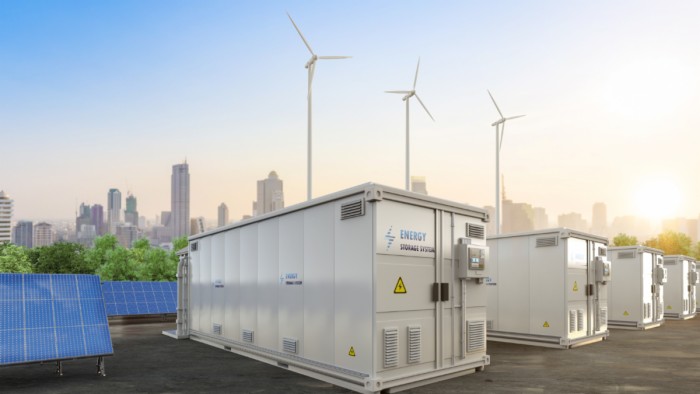What’s Going on in the World of Energy Storage?
 | Alex Thompson, Communications Associate |
 | Delainey Thorud, Member Services Coordinator |

 | Alex Thompson, Communications Associate |
 | Delainey Thorud, Member Services Coordinator |
What is energy storage?
Energy storage is the process of capturing and retaining excess energy for later use. Energy storage systems stabilize fluctuations in energy production and consumption by storing excess energy generated during periods of low demand for later use during periods of high demand. Since energy storage is not an energy producer, it makes money on arbitrage, or buying when the cost of energy is low and selling when the cost of energy is high. When storage is combined with renewable energy generation, this process can lower the cost of energy as it also improves the reliability and efficiency of the electric grid.
Regional Transmission Operators (RTOs), utility companies, and developers are all entering the world of storage. Most Clean Grid Alliance (CGA) members are involved with storage in some capacity, be it storage manufacturing such as Form Energy (Form) and AES, or in developing stand-alone storage and/or hybrid renewable and storage projects.
Regional Transmission Operators Recognizing the Importance of Storage
With an ever-changing resource mix, energy storage plays a vital role in facilitating the transition to a cleaner, more sustainable energy future. Currently, there is a relatively small amount of energy storage on the electric grid in the United States, but RTOs such as the California Independent System Operator (CAISO), the Electric Reliability Council of Texas (ERCOT) have already taken significant steps and successfully included energy storage in their energy portfolio, while the Midcontinent Independent System Operator (MISO) is just beginning to embark on that journey.
According to the American Clean Power Association's CleanPower IQ database, California leads the country with over 8,000 megawatts (MW) of energy storage online, and an additional 10,000 MW under construction and in advanced development. Texas follows California with over 4,800 MW online and 5,200 MW under construction and in advanced development.
Clean Grid Alliance Pushes MISO to Advance Energy Storage Policies
MISO is currently well behind CAISO and ERCOT with less than 1,000 MW of storage online. However, MISO does have over 70,000 MW of energy storage projects in the queue waiting for their chance to connect to the grid. CGA has been working to advance energy storage policies and procedures in MISO for years, and we have finally started to make some significant progress.
To bring energy storage online, MISO needs to create a market participation model in its system. This set of rules and software enhancements is essential, and without them, billions of dollars of projects would be at risk as they wait to be studied in MISO's queue. Fortunately, thanks to CGA's advocacy in both the MISO stakeholder process and at the Federal Energy Regulatory Commission (FERC), MISO's third request for delay was denied, and MISO was required to have its storage market participation model in place by June 2022. Also, MISO's business practice was to study storage interconnection requests in a way these resources do not operate, leading to excessively high costs for storage to interconnect. Through CGA's efforts, this practice was changed so that generator interconnection projects in 2022 and beyond no longer have this barrier.
CGA is now shifting its focus to another initiative started in 2023 aiming to have storage studied in specific (rather than general) applications on the system, such as only during certain grid conditions or, in combination with renewables and a load, such as a large data center or hydrogen producing facility. While there are also legal/jurisdictional energy transaction issues to address, CGA is charging forward in addressing the technical aspects and encouraging market participation constructs to enable these projects.
Utility Companies are Introducing Storage Projects
Utilities are eager to use energy storage because they, too, recognize the importance of modernizing and stabilizing the electric grid. They also appreciate the ability of storage to capture low-cost renewable energy when it is plentiful and then to dispatch it at peak times. Many utilities are investing in energy storage projects, both large and small, and are simultaneously exploring new storage technologies including long-duration storage.
Subscribe to our newsletter for the latest on energy & our work
As an example, Xcel Energy (Xcel) is getting into the energy storage business. Xcel provides electricity to more than 3.7 million customers in 8 Western and Midwestern states. Xcel has pledged to be a net-zero energy producer by 2050 and aims to reduce carbon emissions by 80% by 2030. To do this, Xcel is partnering with CGA member Form Energy to deploy iron-air battery systems at two of its retiring coal plants in Minnesota and Colorado. Both projects will have 10 MW or 1,000 MWh of energy storage and are expected to come online as early as 2025. This means these batteries can provide 10MW of power for 100 hours (about 4 days).
Iron-air batteries are "in"
Form Energy's partnership with Xcel is monumental because it will produce one of the first sets of energy storage projects to use iron-air batteries instead of lithium-ion batteries, which are usually limited to 4-hour durations. Iron-air batteries are also not limited by the sourcing of precious metals that are often hard to obtain. According to Form, "the active components of [their] iron-air battery system are some of the safest, cheapest, and most abundant materials on the planet — low-cost iron, water, and air." Form also states that these batteries can store energy at one-tenth of the cost of lithium-ion battery technologies.
These two projects represent the first time that Form's iron-air batteries will be tested for commercial use. Form co-founder and CEO Mateo Jaramillo told Canary Media that this is a trial run for the technology, stating "these long-duration storage units are big enough to give Xcel a 'meaningful' test of the technology in real field conditions."
While long-duration iron-air batteries are just starting to be put into service, lithium-ion batteries have withstood the test of time. Lithium-ion batteries became popular in the 1990s and are currently the most common form of battery used in energy storage. These short-duration batteries are used to power many everyday electronics such as cell phones, laptops, tools, appliances, and most electric vehicles. Lithium-ion batteries remain popular for their fast and safe charging, increased capacity, long shelf-life and life cycle, replaceability, cost effectiveness, temperature tolerance, and because they are lightweight, making them easier to install and more scalable. The most important difference between lithium-ion and iron-air batteries is their duration. Long-duration storage is essential to a reliable and sustainable energy grid.
Another up-and-coming battery storage option is long-duration flow batteries. Flow batteries can last up to 12 hours and have an unlimited life cycle with no capacity degradation over their 25-year lifespan. Due to the extended lifespan, flow batteries can offer a lower levelized cost of storage with the cost of ownership being up to 40% less than it is for lithium-ion batteries. Part of the cost savings come from not needing high-tech ventilation systems because these batteries can operate in conditions ranging from 14 degrees Fahrenheit to 140 degrees Fahrenheit. Researchers at MIT are working on developing flow batteries to power the future grid.
Energy Storage is the Future of our Grid
As we work toward transitioning to a clean energy future, energy storage will play a key role in ensuring grid reliability as it also enables the efficient integration and management of renewable energy sources such as wind and solar. Clean Grid Alliance will continue to advocate for common-sense storage policies in the MISO market, while long-duration storage will become even more critical as more coal and gas plants are retired. Most of the existing and planned storage on the system today is limited to a 4-hour duration product. These batteries are very helpful in taking the place of gas peaking plants and in balancing renewables. But long-duration storage has the promise of being a game-changer!